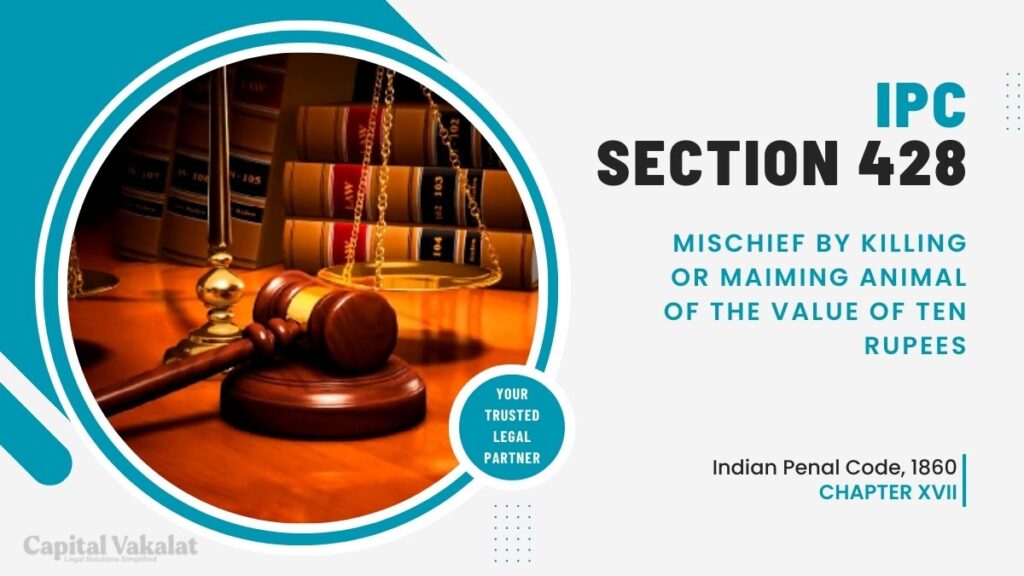In the realm of legal frameworks protecting animals, Section 428 of the Indian Penal Code (IPC) holds a significant place. This provision addresses the issue of mischief by killing or maiming animals of the value of ten rupees or more. As societies evolve, so do the laws that safeguard the rights and well-being of all living beings, including animals.

This article delves into the intricacies of Section 428 IPC, exploring its historical context, real-life cases, impact on animal welfare, challenges in enforcement, penalties, and the role of animal rights organizations.
Understanding Mischief in Legal Terms
Mischief, in legal terms, encompasses a range of actions that cause harm, damage, or destruction to someone else’s property. When this definition is applied to animals, Section 428 IPC comes into play. Committing mischief against animals not only violates ethical standards but also carries legal consequences. The law recognizes the intrinsic value of animals and seeks to protect them from unnecessary harm.
Scope and Applicability of Section 428 IPC
Section 428 IPC specifically addresses the act of killing or maiming animals, emphasizing a value threshold of ten rupees. This brings clarity to the types of animals covered under the provision and ensures that even those with modest economic value are protected. The section aims to deter individuals from engaging in cruelty towards animals, irrespective of their market value.
Historical Context
To appreciate the significance of Section 428 IPC, it’s essential to understand the evolution of animal protection laws in India. Over the years, there has been a growing awareness of the need to safeguard animals from cruelty. Section 428 represents a milestone in this evolution, reflecting a societal commitment to the welfare of all living beings.
Real-life Cases
Examining real-life cases provides insights into the practical application of Section 428 IPC. Notable instances where individuals have faced legal consequences for harming animals shed light on the effectiveness of this provision. Understanding legal outcomes and precedents helps establish a framework for future cases.
Impact on Animal Welfare
Beyond legal ramifications, the protection of animals carries ethical weight. The interconnectedness between animal welfare and societal well-being is evident. Section 428 IPC, by criminalizing mischief against animals, contributes to fostering a compassionate and harmonious society.
Challenges in Enforcing Section 428
Enforcing Section 428 poses unique challenges, such as identifying offenders and navigating legal hurdles. The article explores these challenges and discusses potential solutions to ensure the effective implementation of the law.
Penalties and Punishments
The severity of punishments for violating Section 428 IPC underscores the gravity of animal cruelty. A comparative analysis with other legal provisions reveals the stance of Indian law regarding the protection of animals and the consequences for those who transgress.
Role of Animal Rights Organizations
Non-governmental organizations (NGOs) dedicated to animal rights play a crucial role in enforcing Section 428 IPC. Collaborations between these organizations and law enforcement agencies amplify the impact of the law, creating a network focused on safeguarding animals.
Future Perspectives
As societal values evolve, so should the legal frameworks that protect animals. This section explores potential amendments or improvements to Section 428 IPC, aligning it with global trends in animal protection laws.
Conclusion
In conclusion, Section 428 IPC stands as a pivotal provision in India’s legal system, addressing the issue of mischief against animals. Its historical context, real-life cases, and impact on animal welfare highlight its significance. Despite challenges, the law’s enforcement is bolstered by the efforts of animal rights organizations. Looking ahead, the article discusses potential improvements and aligning Section 428 with evolving global standards.
Frequently Asked Questions
What are the penalties for violating Section 428 IPC?
The penalties for violating Section 428 IPC include imprisonment and fines, the severity of which is determined by the extent of harm caused to the animal.
How can individuals contribute to the enforcement of Section 428 IPC?
Individuals can contribute by reporting cases of animal cruelty, supporting animal rights organizations, and advocating for stricter enforcement of existing laws.
Are there proposed amendments to Section 428 IPC?
The article discusses potential amendments to Section 428 IPC, emphasizing the need for continuous improvement to align with evolving societal values.
Do global trends in animal protection laws influence Section 428 IPC?
The article explores global trends in animal protection laws, providing insights into how Section 428 IPC can be aligned with international standards to better protect animals.